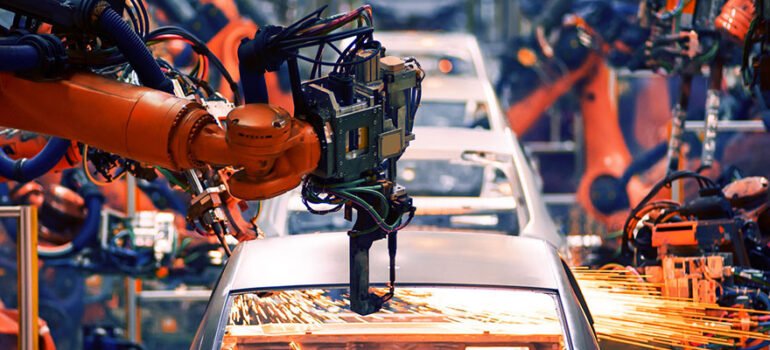Indian Manufacturing Industry – Riding the next growth wave
“The manufacturing sector has been expanding, and this positive trend has to be maintained if India is to achieve its goal of being self-sufficient.”
Since the beginning of the Industrial Revolution, technological breakthroughs have generated tremendous gains in industrial productivity. In the nineteenth century, the steam engine drove industries; electricity enabled mass production in the early twentieth century; and in the 1970s, industries became automated. However, industrial technology gains were merely gradual in the following decades, particularly when compared to the discoveries that altered IT, mobile communications, and e-commerce.
Digitalisation is our fourth significant technological achievement. Sensors and IT systems will be integrated throughout the value chain for automation. A connected system may interact via Internet protocols and analyse data to identify failure, configure, or respond to changes. Automation will allow faster, more flexible, and more efficient processes to make higher-quality items at a reduced cost by analysing machine data.
India can accelerate its transition into the world’s manufacturing powerhouse by combining innovative production technology and automation with the country’s low-cost labour. The manufacturing industry in India has been on a growing trajectory since 2006. There has been an average increase of around 5.89% annually.
The spread of the pandemic, along with other unanticipated challenges like wars, significantly influenced the growth rate. Due to the unpredictability of the current political and economic climate, it is essential for India to be able to produce a diverse range of products and services. The manufacturing sector has been expanding, and this positive trend has to be maintained if India is to achieve its goal of being self-sufficient.
Industry 4.0, also known as the fourth industrial revolution or smart manufacturing, has the potential to play a pivotal role in India’s transition to become the manufacturing powerhouse of the world by adding value to a wide variety of facets. Emerging technologies such as computational power, the internet of things (IoT), business analytics, advanced robotics, artificial intelligence, additive manufacturing/3D printing, augmented reality, etc., are all a part of what is known as Industry 4.0, which is an amalgamation of these technologies.
The most significant influence on production is exerted by additive manufacturing, autonomous robots, digital manufacturing, the industrial internet, and agile product development. In the future smart factories, operations may be handled with high reliability and little human intervention. Incorporating key features of a smart factory, such as automated operations, improved monitoring and scheduling, decreased energy consumption, and asset synchronisation will improve uptime, quality, and production while lowering costs and waste.
Due to the country’s low industrial complexity, automation investment may be modest in many areas (the countries which have already touched peak levels of productivity in manufacturing need now to invest in going to the next level). The Indian industry may ‘leapfrog’ the Automation Wave by employing already-available automation technology to manufacture world-class products.
The manufacturing industry in India is predicted to increase six-fold by 2025 due to rising demand driven by consumer spending and the country’s transition into a low-cost manufacturing hub. Another upside of India’s manufacturing being on the upward trajectory is that there is a ton of pent-up demand for goods and services being generated post-pandemic. The pandemic caused a devastating impact on consumer expenditure because of the uncertainty of the economy. India can take advantage of this global demand by being a leading exporter of goods and services.
However, in order to make the most of the potential, manufacturers in India will need to make significant strides in improving their productivity. The government of India has undertaken a number of specialised efforts, such as the “Make in India” and the “Digital India” campaigns, in order to enhance the ecosystem that is necessary to propel the transformation of the nation.
In India, the new technology-enabled trend in training is beginning to gain traction, and a number of businesses and organisations are beginning to use experiential learning activities as part of their corporate learning programmes.
The manufacturing industry in India is on the verge of undergoing a significant technological shift. India’s progress toward becoming the world’s manufacturing powerhouse may be sped up by adopting cutting-edge manufacturing technologies and combining them with the low-cost labour that is now available in the nation.
In conclusion, given the advent of increasingly complex ecosystems consisting of fragmented and concentrated entities across an expanding diversity of industrial value chains, manufacturers who understand developing automation in their manufacturing processes will have a substantial competitive edge over their competitors. As the industrial environment continues to change and competitive pressure grows, automation will matter more than ever before.
In order to be successful in today’s continuously changing world, there is no one playbook—and no single road to success. Incumbents and new manufacturing industry entrants may benefit from a better awareness of these movements, responsibilities, and impact points.
Since the beginning of the Industrial Revolution, technological breakthroughs have generated tremendous gains in industrial productivity. In the nineteenth century, the steam engine drove industries; electricity enabled mass production in the early twentieth century; and in the 1970s, industries became automated. However, industrial technology gains were merely gradual in the following decades, particularly when compared to the discoveries that altered IT, mobile communications, and e-commerce.
Digitalisation is our fourth significant technological achievement. Sensors and IT systems will be integrated throughout the value chain for automation. A connected system may interact via Internet protocols and analyse data to identify failure, configure, or respond to changes. Automation will allow faster, more flexible, and more efficient processes to make higher-quality items at a reduced cost by analysing machine data.
India can accelerate its transition into the world’s manufacturing powerhouse by combining innovative production technology and automation with the country’s low-cost labour. The manufacturing industry in India has been on a growing trajectory since 2006. There has been an average increase of around 5.89% annually.
The spread of the pandemic, along with other unanticipated challenges like wars, significantly influenced the growth rate. Due to the unpredictability of the current political and economic climate, it is essential for India to be able to produce a diverse range of products and services. The manufacturing sector has been expanding, and this positive trend has to be maintained if India is to achieve its goal of being self-sufficient.
Industry 4.0, also known as the fourth industrial revolution or smart manufacturing, has the potential to play a pivotal role in India’s transition to become the manufacturing powerhouse of the world by adding value to a wide variety of facets. Emerging technologies such as computational power, the internet of things (IoT), business analytics, advanced robotics, artificial intelligence, additive manufacturing/3D printing, augmented reality, etc., are all a part of what is known as Industry 4.0, which is an amalgamation of these technologies.
The most significant influence on production is exerted by additive manufacturing, autonomous robots, digital manufacturing, the industrial internet, and agile product development. In the future smart factories, operations may be handled with high reliability and little human intervention. Incorporating key features of a smart factory, such as automated operations, improved monitoring and scheduling, decreased energy consumption, and asset synchronisation will improve uptime, quality, and production while lowering costs and waste.
Due to the country’s low industrial complexity, automation investment may be modest in many areas (the countries which have already touched peak levels of productivity in manufacturing need now to invest in going to the next level). The Indian industry may ‘leapfrog’ the Automation Wave by employing already-available automation technology to manufacture world-class products.
The manufacturing industry in India is predicted to increase six-fold by 2025 due to rising demand driven by consumer spending and the country’s transition into a low-cost manufacturing hub. Another upside of India’s manufacturing being on the upward trajectory is that there is a ton of pent-up demand for goods and services being generated post-pandemic. The pandemic caused a devastating impact on consumer expenditure because of the uncertainty of the economy. India can take advantage of this global demand by being a leading exporter of goods and services.
However, in order to make the most of the potential, manufacturers in India will need to make significant strides in improving their productivity. The government of India has undertaken a number of specialised efforts, such as the “Make in India” and the “Digital India” campaigns, in order to enhance the ecosystem that is necessary to propel the transformation of the nation.
In India, the new technology-enabled trend in training is beginning to gain traction, and a number of businesses and organisations are beginning to use experiential learning activities as part of their corporate learning programmes.
The manufacturing industry in India is on the verge of undergoing a significant technological shift. India’s progress toward becoming the world’s manufacturing powerhouse may be sped up by adopting cutting-edge manufacturing technologies and combining them with the low-cost labour that is now available in the nation.
In conclusion, given the advent of increasingly complex ecosystems consisting of fragmented and concentrated entities across an expanding diversity of industrial value chains, manufacturers who understand developing automation in their manufacturing processes will have a substantial competitive edge over their competitors. As the industrial environment continues to change and competitive pressure grows, automation will matter more than ever before.
In order to be successful in today’s continuously changing world, there is no one playbook—and no single road to success. Incumbents and new manufacturing industry entrants may benefit from a better awareness of these movements, responsibilities, and impact points.
by Rajiev Luthra, Director at Luthra Hydro Pneumatic Industries









